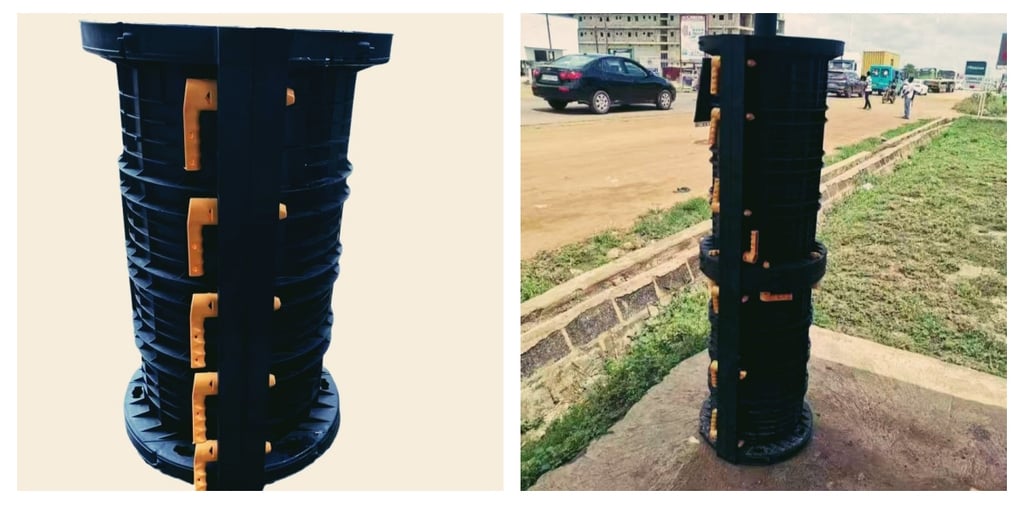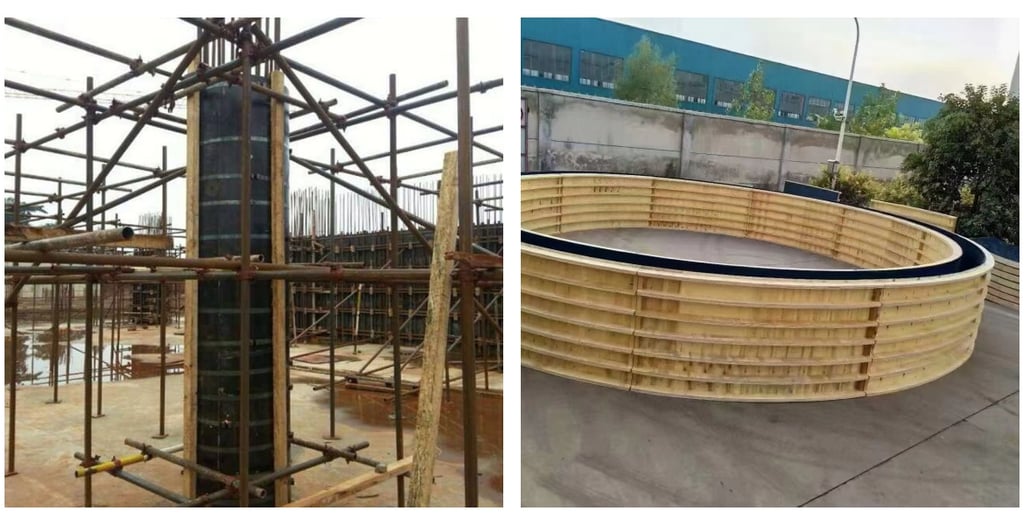Get cost-effective formwork solutions today!
How to Make Round Concrete Forms: Choosing the Right Material for Your Project
Round concrete structures, from decorative columns in residential landscapes to functional pillars in commercial buildings, demand precise formwork to achieve smooth curves and structural integrity.
7/25/20254 min read


Plastic Forms for 300-450mm Diameters
Plastic round concrete forms, typically made from high-density polypropylene (PP), are engineered to meet the needs of small to medium-sized cylindrical structures. These materials offer unique properties that make them ideal for diameters ranging from 300mm to 450mm.
plastic round formwork size:
Diameter:300/350/400/450mm Height:750mm
One of the primary advantages of plastic forms is their lightweight design. Compared to wooden alternatives, plastic templates are significantly easier to transport, handle, and install, reducing labor costs and physical strain during setup. Their inherent flexibility allows them to maintain consistent curvature without cracking, ensuring a uniform circular shape for smaller diameters. The smooth, non-porous surface of plastic forms produces concrete with a polished finish, minimizing the need for post-casting polishing or refinishing—an especially valuable feature for visible structural elements like landscape columns or interior design features.
Plastic forms also excel in water resistance. Unlike wood, they do not absorb moisture, preventing swelling, warping, or dimensional changes that could compromise the accuracy of the concrete structure. This waterproof property also extends their lifespan, as they resist rot, mold, and degradation from repeated exposure to water and concrete mixtures. With proper care, high-quality plastic forms can be reused 20 to 30 times, making them a cost-effective option over the long term for projects requiring multiple identical cylindrical elements.
However, plastic forms have limitations. Their temperature sensitivity can be problematic in extreme conditions—they may become brittle in cold weather, increasing the risk of cracks, and soften in high heat, potentially losing their shape under concrete pressure. Initial costs are often higher than wooden forms, which can be a barrier for small-scale projects or one-time uses. Additionally, plastic’s rigidity limits customization; while prefabricated sizes work well for standard 300-450mm diameters, altering dimensions or creating irregular curves requires specialized manufacturing, which is less feasible than modifying wood on-site.


Wooden Forms for Diameters Over 450mm
For larger cylindrical structures with diameters exceeding 450mm, wooden forms—typically made from plywood, are the preferred choice. Their structural properties better accommodate the increased lateral pressure exerted by larger volumes of wet concrete.
wooden round formwork size:
Diameter:any size can be customed Height:2400mm
Wooden forms offer superior load-bearing capacity compared to plastic, making them capable of withstanding the higher hydrostatic pressure generated by deeper or wider concrete pours. This rigidity ensures stability during curing, preventing bulging or deformation that could ruin the structure’s integrity. Wood’s versatility is another key advantage: it can be easily cut, shaped, and adjusted on-site with basic tools, allowing contractors to customize dimensions, incorporate openings, or modify curves to meet specific project requirements—an essential feature for large, non-standard structures like industrial columns or public art installations.
Cost-effectiveness is another benefit of wooden forms, especially for large diameters. The lower initial material cost of plywood or lumber makes them attractive for one-time projects or custom designs where reusable plastic forms would be impractical. Wood also adapts well to various connection methods, including nails, screws, and clamps, enabling secure assembly even for complex circular configurations. Unlike plastic, wood performs consistently across a wide range of temperatures, maintaining strength in both cold and hot climates without significant degradation.
Despite these advantages, wooden forms have notable drawbacks. Their porous nature makes them prone to water absorption, which can cause swelling, warping, or uneven curing if not properly sealed. This requires additional steps like applying waterproof coatings or sealants, increasing preparation time and labor costs. The rough surface of wood often leaves concrete with a textured finish, necessitating extra 打磨 (sandblasting) or refinishing work.
Wooden forms also have a shorter lifespan than plastic ones, typically lasting only 5 to 10 uses before showing signs of wear, delamination, or structural weakness. They are heavier than plastic, requiring more workers or equipment for transportation and installation—a significant consideration for large-diameter forms, which can be cumbersome to maneuver. Finally, wood’s environmental impact is a concern, as it relies on forest resources, though using sustainably sourced lumber or recycled wood products can mitigate this issue.
Conclusion: Matching Form to Function
Choosing between plastic and wooden round concrete forms ultimately depends on the diameter of the structure and project-specific needs. For diameters between 300mm and 450mm, plastic forms offer precision, durability, and ease of use, making them ideal for small to medium-sized, reusable applications. For larger diameters over 450mm, wooden forms provide the strength, flexibility, and cost efficiency required to handle increased pressure and customization demands. By aligning material properties with project requirements, builders can ensure successful, high-quality results in their round concrete constructions.
Round concrete structures, from decorative columns in residential landscapes to functional pillars in commercial buildings, demand precise formwork to achieve smooth curves and structural integrity. The key to successful round concrete forming lies in selecting the right template material, and diameter size plays a critical role in this decision. For cylindrical structures with diameters between 300mm and 450mm, plastic round formwork are often the optimal choice, while wooden forms are more suitable for diameters exceeding 450mm. Understanding the advantages and disadvantages of each material will help you make informed decisions for your specific project.

Get in touch
contac us for best price about round formwork!
